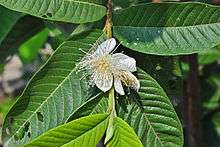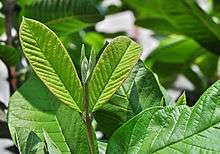Psidium guajava
| Common guava | |
|---|---|
 | |
| Common guava (Psidium guajava) fruit | |
| Scientific classification | |
| Kingdom: | Plantae |
| (unranked): | Angiosperms |
| (unranked): | Eudicots |
| (unranked): | Rosids |
| Order: | Myrtales |
| Family: | Myrtaceae |
| Subfamily: | Myrtoideae |
| Tribe: | Myrteae |
| Genus: | Psidium |
| Species: | P. guajava |
| Binomial name | |
| Psidium guajava L. | |



Psidium guajava, the common guava,[1] yellow guava,[1] or lemon guava[1] (known as goiaba in Portuguese and guayaba in Spanish) is an evergreen shrub or small tree native to the Caribbean, Central America and South America.[1] It is easily pollinated by insects; in culture, mainly by the common honey bee, Apis mellifera.
Overview

Widely cultivated in tropical and subtropical regions around the world, guava fruits can range in size from as small as an apricot to as large as a grapefruit. Various cultivars have white, pink, or red flesh, and a few also feature red (instead of green or yellow) skin.
When cultivated from seed, guavas are notable for an extremely slow growth rate for several months, before a very rapid acceleration in growth rate takes over. From seed, common guavas may bloom and set fruit in as few as two years or as many as eight. Cuttings and grafting are more commonly used as a propagation method in commercial groves. Highly adaptable, guavas can be easily grown as container plants in temperate regions, though their ability to bloom and set fruit is somewhat less predictable. In some tropical locales, guavas can become invasive. It has become a major problem in the Galápagos Islands.[2]
The plant is used in many different shampoo products for its scent. It is also becoming a popular bonsai species and is currently quite popular in India and Eastern Asia.[3]
Climate and soil
Owing to its hardy nature, guava is grown successfully in tropical and subtropical regions up to 1,500 m (4,900 ft) above mean sea-level. Best quality guavas are obtained where low night temperatures, 10 °C (50 °F), prevail during winter. It tolerates high temperatures and drought conditions in North India during summers but it is susceptible to severe frost as it can kill the young plants. An annual rainfall of about 100 cm (39 in) is sufficient during the rainy season (July–September). The rains during harvesting period, however, deteriorate the quality of fruits.
Guava is cultivated on varied types of soils- heavy clay to very light sandy soils. Nevertheless, very good quality guavas are produced in river-basins. It tolerates a soil pH of 4.5-8.2. Maximum concentration of its feeding roots is available up to 25 cm (9.8 in) soil depth. Thus the top soil should be quite rich to provide enough nutrients for accelerating new growth which bears fruits.
Varieties

The varietals characteristics in guava are not as distinct as found in most other fruits. Its propagation through seeds reduces the distinctive characteristics of a variety in commercial cultivation. Important guava varieties are:
- Lucknow 49
Also known as Sardar, its fruits are large, roundish ovate in shape, skin primrose yellow and pulp white, very sweet and tasty. The total soluble solids (TSS) and vitamin C contents are high. The trees are vigorous.
- Allahabad Safeda
The most famous variety of Allahabad, it has acquired large variations due to seed propagation. The fruits are large in size, round in shape, skin smooth and yellowish white. The flesh is white, firm, soft having pleasant flavour, high TSS and vitamin C content. The seeds are numerous, bold and hard. The trees are tall with profuse branching and broad crown. It can withstand drought conditions.[4]
- Chittidar
The variety is very popular in western Uttar Pradesh. The fruits are characterized by numerous red dots on the skin, high sweetness, and small and soft seeds. It is otherwise similar to Allahabad safeda fruits in size, shape and pulp. It has higher TSS content than Allahabad Safeda and Lucknow 49 but lower vitamin C content. The tree characters resemble to those of Allahabad Safeda.[4]
- Harijha
Harijha is more popular in Bihar because of profuse bearing. The trees are of medium vigor due to sparse branching. The fruit is round in shape, medium large in size and greenish yellow in color. Flavor is sweet with good keeping quality.
- Hafshi
It is a tasty, red- fleshed guava. It is mainly grown in Bihar. The fruit is moderately large and spherical in shape, with thin skin. Trees are of medium vigor but productive.
- Apple guava
Its fruits are medium-sized and pink colored. They are sweet in taste with good keeping quality. They require low temperature for the development of good pink color. The trees are of medium vigor but their leaves are greener than others. However, it is a moderate yielder.
- Fruits of sebia
(looking like apple) variety low temperature for the development of good pink color. The trees are of medium vigour but their leaves are greener than others. However, it is a moderate yielder.
- Seedless
All the seedless varieties viz. Saharanpur Seedless, Nagpur seedless and others, are the same. Two types of fruits, completely seedless and partly seeded, are borne on a plant of seedless variety. The completely seedless fruits develop on the shoots rising from the stem and these are bigger in size and irregular in shape. The partly seeded fruits are born on normal shoots at the periphery and are small in size and round in shape. Seedless variety is unfit for commercial cultivation because it gives very low yield. The plants are very vigorous.
- Arka Mridula
This is a seedling selection of variety Allahabad Safeda. Its medium-sized fruits are of excellent quality with high TSS. The white pulp has only few soft seeds. The plants are of medium vigor but high yielding.
This is an outstanding variety of large, uniform pink fruits with deep pink flesh. The plants produce up to 120 kg (260 lb) fruits in its sixth year of fruiting. The fruit is sweet, strongly flavored with few seeds and is slightly depressed at both ends. The plants are vigorous, dome shaped and compact.
Chemistry
The leaves of P. guajava contains the flavonol morin, morin-3-O-lyxoside, morin-3-O-arabinoside, quercetin and quercetin-3-O-arabinoside.[5]
Wood
Guava wood from Hawaii is commonly used for the smoking of meat. The wood is resistant to insect and fungal attack. The density of oven-dry wood is about 670 kg/m3 (1,130 lb/cu yd) and has been found suitable for roof trusses in Nigeria.[6]
Traditional medicine
Psidium guajava has been used in traditional medicine in many cultures throughout Central America, the Caribbean, Africa, and Asia.[7] It is used for inflammation, diabetes, hypertension, caries, wounds, pain relief, fever, diarrhea, rheumatism, lung diseases, and ulcers.[7][8]
References
- 1 2 3 4 "Psidium guajava". Germplasm Resources Information Network. USDA. October 17, 1995. Retrieved February 6, 2009.
- ↑ http://www.wondermondo.com/Countries/SA/Ecuador/Galapagos/ScalesiaSantaCruz.htm
- ↑ D'Cruz, Mark. "Ma-Ke Bonsai Care Guide for Psidium guajava". Ma-Ke Bonsai. Retrieved April 22, 2011.
- 1 2 http://www.fruitipedia.com/guava.htm
- ↑ Bacteriostatic effect of flavonoids isolated from leaves of Psidium guajava on fish pathogens. Rattanachaikunsopon Pongsak and Phumkhachorn Parichat, Fitoterapia, 2007, volume 78, number 6, pages 434-436, INIST:19087798
- ↑ https://ecommons.library.cornell.edu/bitstream/1813/10508/1/BC%2005%20010%20Olorunnisola%20final%2017June2006.pdf
- 1 2 "Psidium guajava: A review of its traditional uses, phytochemistry and pharmacology". Journal of Ethnopharmacology. 117: 1–27. 2008. doi:10.1016/j.jep.2008.01.025.
- ↑ K.A. Sanda, H.A. Grema, Y.A. Geidam and Y.M. Bukar-Kolo (2011). "Pharmacological Aspects of Psidium guajava: An Update". International Journal of Pharmacology. 7 (3): 316–324. doi:10.3923/ijp.2011.316.324.
Further reading
- Flores, Gema; Wu, Shi-Biao; Negrin, Adam; Kennelley, Edward J. (1 March 2015). "Chemical composition and antioxidant activity of seven cultivars of guava (Psidium guajava) fruits". Food Chemistry. 170: 327–335. doi:10.1016/j.foodchem.2014.08.076.
- Gomes Moraes, Sylvia Raquel; Escanferla, Maria Eugenia; Massola, Nelson Sideni Jr. (Mar 2015). "Prepenetration and Penetration of Colletotrichum gloeosporioides into Guava Fruit (Psidium guajava L.): Effects of Temperature, Wetness Period and Fruit Age". Journal of Phytopathology. 163 (3): 149–159. doi:10.1111/jph.12294.
- Bazihizina, Nadia; Redwan, Mirvat; Taiti, Cosimo (February 2015). "Root based responses account for Psidium guajava survival at high nickel concentration". Journal of Plant Physiology. 174: 137–146. doi:10.1016/j.jplph.2014.10.011.
External links
| Wikimedia Commons has media related to Psidium guajava. |
![]() Data related to Psidium guajava at Wikispecies
Data related to Psidium guajava at Wikispecies
- (Portuguese) Federal University of Uberlândia: Culture of Apple Guava
- Guava: a nutritious tropical fruit